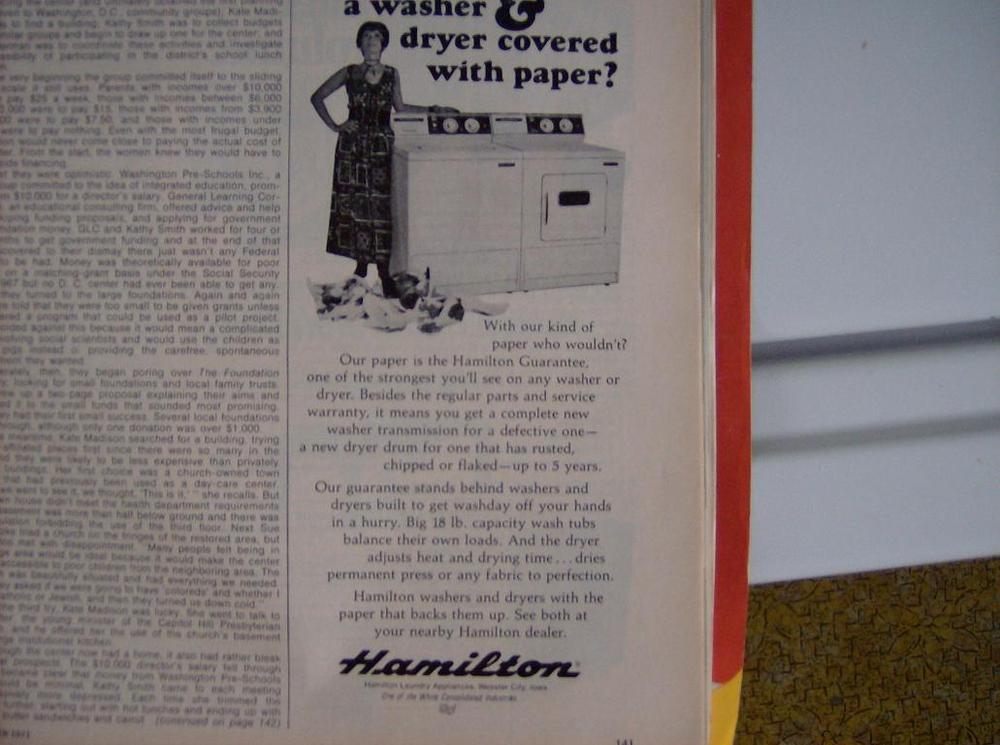|
Thread Number: 25189
Hamilton |
[Down to Last] |

|
Post# 388494 , Reply# 1 10/27/2009 at 13:23 (5,287 days old) by turquoisedude  (.) (.) |
||
I don't believe they were related
I don't know much about the Hamilton brand of washers and dryers but I think they were made by a distinct company, not related to Hamilton-Beach (they made mostly smaller appliances). I can't say I ever heard of Hamilton marketing their appliances in Canada, either. Beach was a Canadian brand name - I still see Beach ranges turn up in the local used appliance stores! I think they were related to the Findlay company (they made ranges too)... | ||
| Post# 388520 , Reply# 2 10/27/2009 at 15:16 (5,287 days old) by everythingold (Grand Rapids, Michigan) | ||
 | ||
| Post# 388620 , Reply# 5 10/27/2009 at 20:52 (5,287 days old) by laundromat (Hilo, Hawaii) | ||
Hamilton dryers | ||
| Post# 388731 , Reply# 6 10/28/2009 at 10:07 (5,286 days old) by davy1063 (Pennsylvania) | ||
|
and one cannot forget.... the Sun-E-Day ozone lamp. My aunt (who coincidentally lived in Pittsburgh at the time) had one. | ||
| Post# 388807 , Reply# 9 10/28/2009 at 14:21 (5,286 days old) by macboy91si (Frankfort, KY) | ||
Local Laundromat
...has some very old Cissell gas fired units with the burner on the top and perf drums. They still take dimes and 20 min or less for a load. The access panels are all charred from 40+ years or heat at the burners. They're so cool, it's a very old working laundry lots of old stuff, making a new post on it. -Tim | ||
Post# 388854 , Reply# 11 10/28/2009 at 18:47 (5,286 days old) by combo52  (50 Year Repair Tech Beltsville,Md) (50 Year Repair Tech Beltsville,Md) |
||
Early hamilton dryers | ||
Post# 388901 , Reply# 12 10/28/2009 at 21:14 (5,286 days old) by appliguy  (Oakton Va.) (Oakton Va.) |
||
I knew that Hamiliton made the early Frigidaire Dryers but.. | ||
| Post# 388906 , Reply# 14 10/28/2009 at 21:38 (5,286 days old) by ingliscanada () | ||
|
What about Blackstone? Were Blackstone dryers also made by Hamilton, or just built simularily? Were they almost silent, with the small exhaust duct? | ||
| Post# 389039 , Reply# 16 10/29/2009 at 10:45 (5,285 days old) by everythingold (Grand Rapids, Michigan) | ||
 | ||
| Post# 390473 , Reply# 18 11/3/2009 at 12:46 (5,280 days old) by rpm () | ||
|
I found this ad in a Woman's Day magazine, 1971. 
| ||
| Post# 390513 , Reply# 19 11/3/2009 at 15:49 (5,280 days old) by davy1063 (Pennsylvania) | ||
|
Did you notice the fine print??? Under the Hamilton script. "One of the White Consolidated Industries". Ugh! | ||
Post# 390518 , Reply# 20 11/3/2009 at 16:14 (5,280 days old) by gansky1  (Omaha, The Home of the TV Dinner!) (Omaha, The Home of the TV Dinner!) |
||
 | ||
| Post# 390530 , Reply# 21 11/3/2009 at 17:10 (5,280 days old) by mickeyd (Hamburg NY) | ||
Hey Brian --rmp
I just blew up the pic of you wringing your hand--pretty wild and funny ! BUT WHAT is that gorgeous turquoise agitator in your washer? It looks part Spiralator, part Hotpoint fountain-flo. What brand is the washer and is their an American equivalent. Thank you for your time. Great scan. Love the giant eyeball dials; they look like they're spying out of the lower left corners. Mickey | ||

 Comes to the Rescue!
Comes to the Rescue!